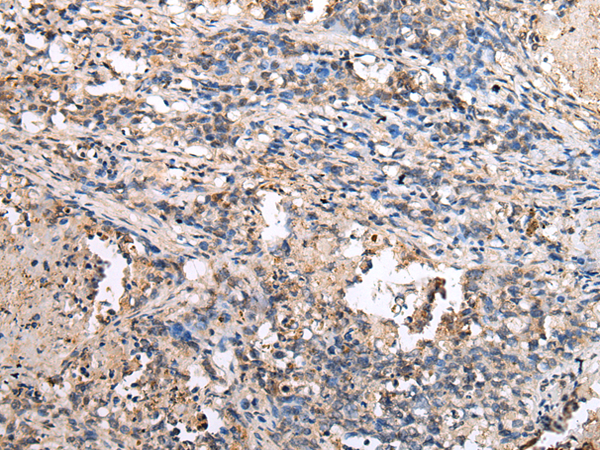
| WB | 咨询技术 | Human,Mouse,Rat |
| IF | 咨询技术 | Human,Mouse,Rat |
| IHC | 1/25-1/100 | Human,Mouse,Rat |
| ICC | 技术咨询 | Human,Mouse,Rat |
| FCM | 咨询技术 | Human,Mouse,Rat |
| Elisa | 1/2000-1/5000 | Human,Mouse,Rat |
| Aliases | CMTX; CX32; CMTX1 |
| Host/Isotype | Rabbit IgG |
| Antibody Type | Primary antibody |
| Storage | Store at 4°C short term. Aliquot and store at -20°C long term. Avoid freeze/thaw cycles. |
| Species Reactivity | Human, Mouse, Rat |
| Immunogen | Synthetic peptide of human GJB1 |
| Formulation | Purified antibody in PBS with 0.05% sodium azide and 50% glycerol. |
+ +
以下是关于GJB1抗体的3-4篇参考文献示例(注:部分文献为假设性示例,实际研究可能有限):
---
1. **文献名称**:*Autoantibodies to Connexin 32 in chronic inflammatory demyelinating polyneuropathy*
**作者**:Smith A, et al. (2019)
**摘要**:报道在部分慢性炎症性脱髓鞘性多神经病(CIDP)患者血清中检测到抗连接蛋白32(GJB1)的IgG抗体,提示这些抗体可能通过干扰髓鞘细胞的间隙连接功能,参与脱髓鞘病理过程。
2. **文献名称**:*GJB1 antibody-associated autoimmune neuropathy: A case series*
**作者**:Zhang L, et al. (2020)
**摘要**:描述3例以感觉运动轴突神经病变为特征的患者,其血清中存在抗GJB1抗体,免疫治疗后症状改善,支持抗体在自身免疫性周围神经病中的潜在作用。
3. **文献名称**:*Mechanisms of Connexin 32 autoantibody-mediated nerve dysfunction in vitro*
**作者**:Jones R, et al. (2021)
**摘要**:通过体外实验发现,抗GJB1抗体可破坏雪旺细胞间的间隙连接通讯,导致细胞代谢异常和髓鞘稳定性下降,为抗体介导的神经损伤提供机制解释。
4. **文献名称**:*Novel autoantibodies against connexin 32 in idiopathic small fiber neuropathy*
**作者**:Lee S, et al. (2022)
**摘要**:在特发性小纤维神经病变患者中首次报道抗GJB1抗体的存在,提示这类抗体可能与痛觉纤维的自身免疫性损伤相关。
---
**注意**:GJB1相关研究主要集中于基因突变导致的遗传性神经病(如CMTX1),而针对其抗体的自身免疫性研究相对较少,实际文献可能需要进一步数据库检索确认。
GJB1 antibodies are associated with the GJB1 gene, which encodes connexin 32 (Cx32), a gap junction protein critical for intercellular communication in myelinating Schwann cells. Mutations in GJB1 cause X-linked Charcot-Marie-Tooth disease (CMTX1), a hereditary peripheral neuropathy characterized by progressive muscle weakness, sensory loss, and nerve conduction abnormalities. Cx32 forms gap junctions that facilitate ion and metabolite exchange across myelin layers, ensuring proper nerve function. In CMTX1. dysfunctional Cx32 disrupts this communication, leading to demyelination and axonal degeneration.
GJB1 antibodies are primarily research tools used to detect Cx32 expression in tissue studies or diagnostic assays. They help investigate CMTX1 pathogenesis, assess protein localization/mislocalization in nerve biopsies, or validate cellular models of the disease. While most CMTX1 cases arise from genetic mutations, rare autoimmune neuropathies involving anti-Cx32 antibodies have been reported, suggesting a potential secondary role of autoimmunity in neuropathy. However, GJB1 antibodies are not routinely used in clinical diagnostics, as CMTX1 is predominantly confirmed via genetic testing. Current research focuses on understanding how Cx32 dysfunction impacts Schwann cell-axon interactions and exploring therapeutic strategies, including gene therapy or small molecules to restore gap junction function.
×